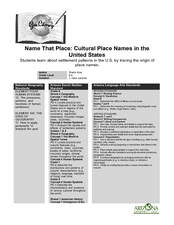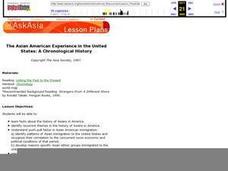Curated OER
Colonial Society on the Eve of Revolution 1700-1775
Six slides show maps, graphs, and trade routes showing the demographics and economy of the early colonial economy. No text is included in this presentation, it is for supplemental use only.
Curated OER
Baseball in Korea
Seventh graders explore the origins of baseball. In this Geography instructional activity, 7th graders compare Korean baseball teams with other countries. Students create a map of all the baseball teams around the world.
Curated OER
Columbus wants to find a shorter route to Asia
Eighth graders identify the reasons why Columbus wanted to find a shorter route to Asia. They make a timeline of the sequence of events surrounding his explorations. Students draw a map of the routes taken by early explorers around...
Curated OER
The High and the Flighty
Students study women aviators and act out a talk show-style interview with one of them. They plot Amelia Earhart's flights on a map.
Curated OER
Immigration Push and Pull Factors
Eighth graders examine significant ideas, beliefs, and themes; organize patterns and events; and analyze how individuals and societies have changed over time in Maryland, the United States, and the world.
Curated OER
Name That Place: Cultural Place Names in the United States
Students examine the origin of the people that settled in the United States. In this United States History instructional activity, students work in small groups to complete several activities that explore early settlement, such as a...
Curated OER
The Asian American Experience in the United States: A Chronological History
Eleventh graders understand push-pull factor in Asian Amencan immigration. They identify patterns of Asian immigration to the United States and recognize their correlation to the concurrent socio-economic and political conditions of that...
Curated OER
The Tet Offensive and the Vietnam War
Students comprehend how the United States became involved in what one historian called the quagmire. Students identify and analyze the importance of the Tet Offensive in turning American public opinion against the Vietnam War. Students...
Curated OER
Settling Nroth America: Improvisation and Playwriting
Students map the classroom by marking the movement of the first Americans' migration from Alaska down into North America. To improve their skills in map-reading and sense of direction, students identify physical features of the map and...
Curated OER
Las Vegas Mormon Fort
Learners use maps, readings, letters, photos and drawings to identify why Mormons came to the Las Vegas area and what they hoped to accomplish by establishing an outpost. They consider the roles of early women pioneers and outline their...
Curated OER
Location of Cities 201
Students work in pairs to locate the ancient cities on a world atlas using the longitude and latitude measurements. They examine the physical and human futures that explain their locations.
Curated OER
Migration and Immigration in the United States: Three Case Studies
Students examine the early migration of Native Americans, African Americans, and the British Colonists. They conduct Internet research, complete a timeline, label maps, compare/contrast the three groups' experiences, and write an essay.
Silos & Smokestacks National Heritage Area
Life as a Pioneer
Students examine historical documents and research why early pioneers settled on the Iowa prairie. They review maps, describe the impact of railroading, describe life in pioneer times, and identify the effects of drought, prairie fire,...
Curated OER
Life on Plymouth Plantation
Third graders research life of Plymouth Plantation and write letters about life there home. In this Plymouth life lesson plan, 3rd graders complete a webquest as they gather information about the journey to America on the Mayflower and...
Curated OER
It’s a Big, Big World
Students examine the role of the explorers. In this explorers and conquistadors, students create word puzzles (Wordles) regarding the time period in history. Students conduct research regarding a particular explorer and create foldables...
PBS
Primary Sources
Students see how to use primary and secondary sources to investigate history. Whether it is a photograph, book, map, letter, postcard, newspaper, or official document, students can use sources to reconstruct and relive history.
Curated OER
Children of Clay
Fourth graders identify and interpret the Pueblo Native American culture and history and comprehend their folklore and songs. They also create their own piece of pottery with clay and write a myth about the piece of pottery they made....
Curated OER
The Cuban Missile Crisis
Students reflect on the events that lead up to the Cuban Missile Crisis in the early 1960s. In this history lesson plan, students explore the conflicts between the United States and the Soviet Union revolving around missiles in Cuba,...
Curated OER
Pioneer America: Journey West
Fourth graders experience pioneer life on the Oregon trail. In this pioneer lesson, 4th graders research the reasons for moving west and what life was like on the trail. They create a map, complete an oral presentation, and write about...
Curated OER
A Colony is Born : Lesson 4 - What Went Wrong?
Fifth graders compare and contrast two early colonies and make a T chart. They list examples of worked well and what did not, and significant historical events. They use higher order thinking skills by deducing how different scenarios...
Curated OER
If I Had Been at Ellis Island
Students examine what it was like to enter the U.S. as an immigrant. They conduct Internet research, develop a concept map, list the ways children occupied their time while at Ellis Island, and create a diorama.
Curated OER
Lesson 1: The Creek War - Return to Nativism or International Pawn? Religious War or International Conflict?
Young scholars investigate the countries and peoples involved in the Creek Indian War. They study the complex relationships between American and European settlers and the native Alabamians in the early 19th Century.
Curated OER
Dark Days on the Prairie
Fourth graders research the location and causes of the Dust Bowl in 1935. In support, they interpret photos from that period in Oklahoma history, They also compare/contrast the American Dust Bowl to the dust storms that occurred in...
Curated OER
The Presidents of Mount Rushmore
Students understand the importance of Mount Rushmore as a national symbol. In this Mount Rushmore lesson, students locate Mount Rushmore on the map and investigate each of the four Presidents on Mount Rushmore. Students understand how...

























